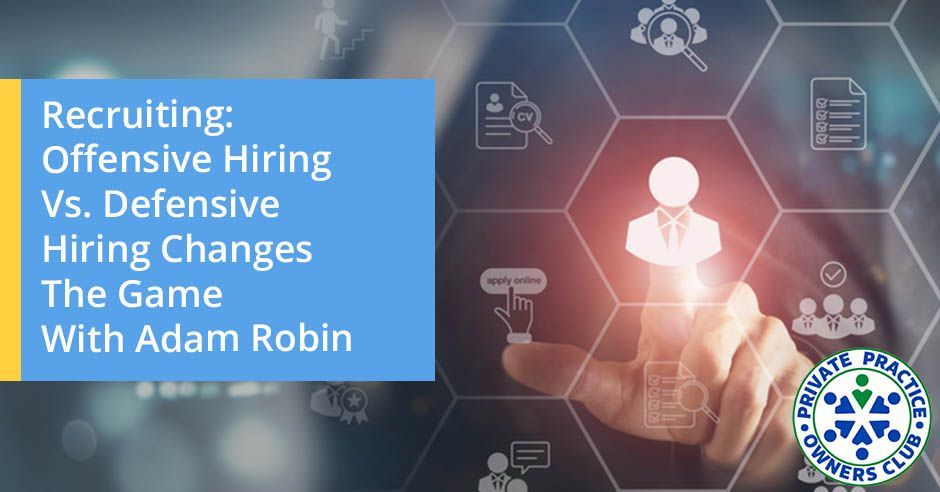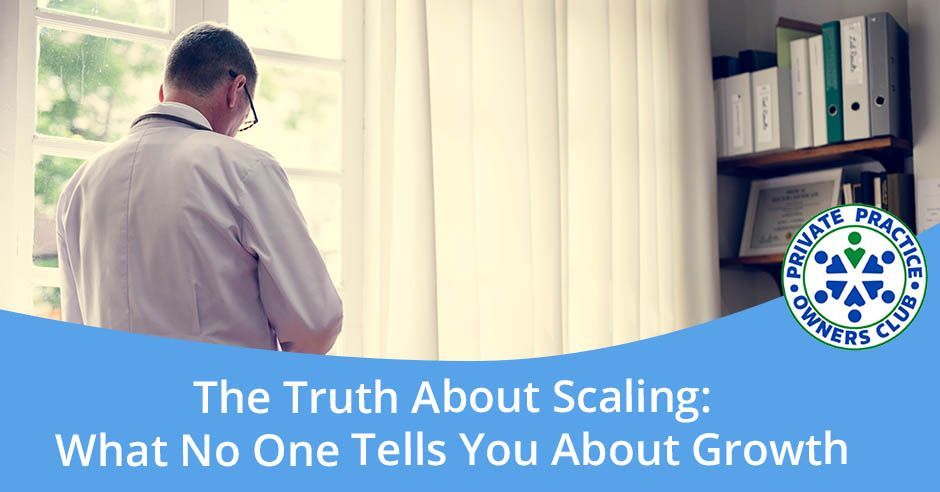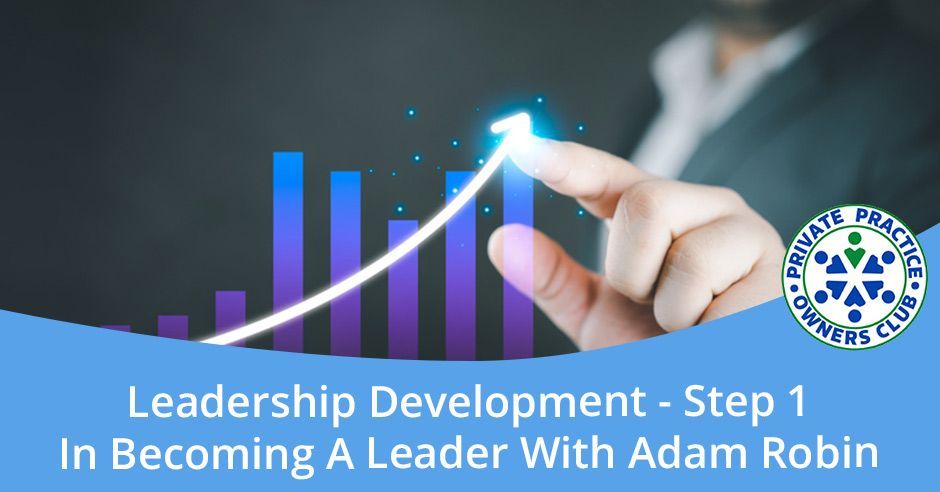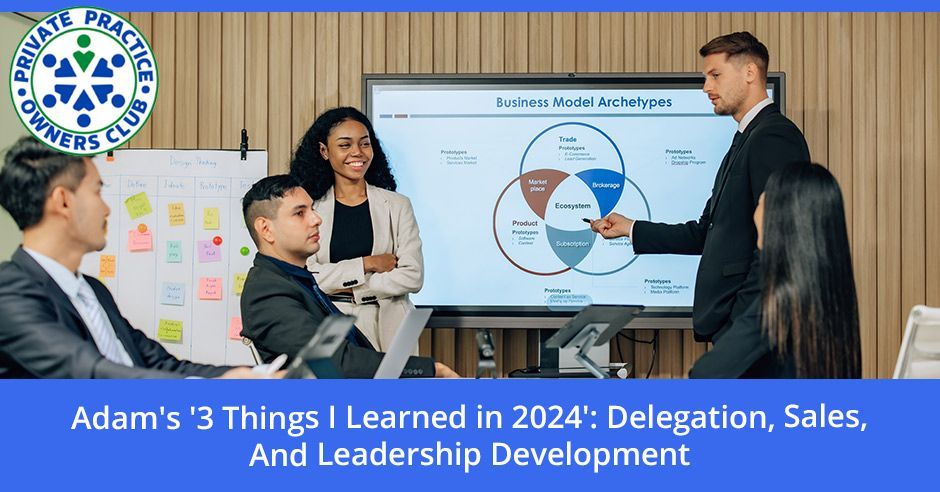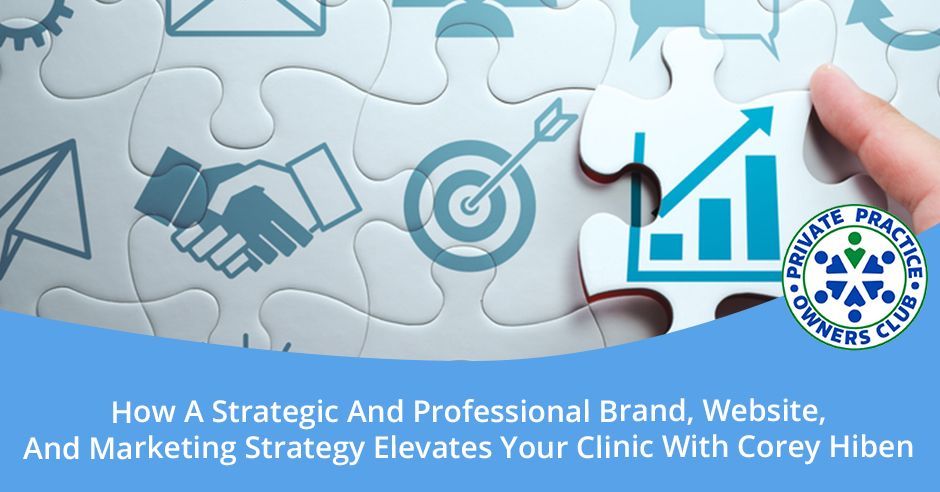The Practice Owner Journey Of Success With Norene Christensen
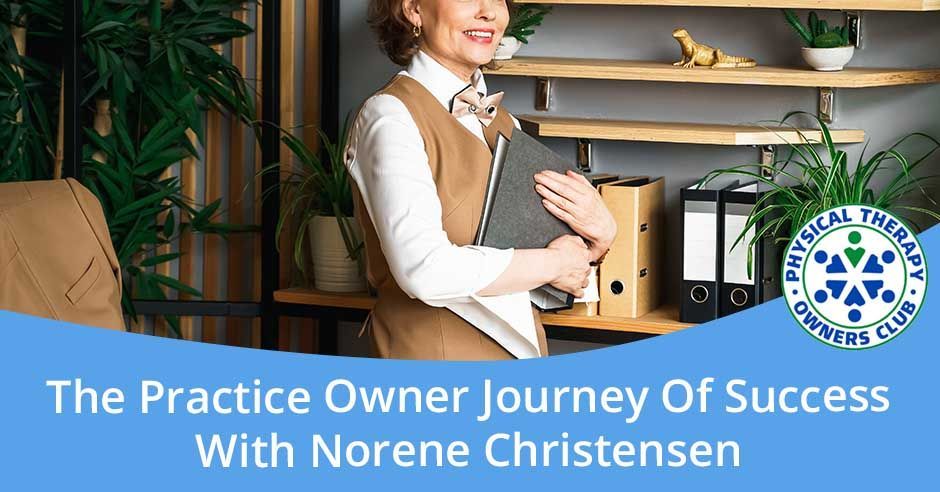
Get ready for an engaging and informative episode of the Physical Therapy Clinic Owners Podcast. In this episode, Adam Robin is joined by Norene Christensen , a highly experienced entrepreneur and physical therapy expert. Together, they delve into some cutting-edge strategies that can help you take your clinic to the next level and achieve sustainable growth.
Throughout the podcast, Adam and Norene explore a range of topics, from building a strong engagement with your patients and attracting new ones to the importance of creating a culture of excellence within your clinic. Norene also offers tips for hiring and retaining top talent in your team.
Ready to take your physical therapy clinic to the next level? With Norene’s expertise and Adam’s insightful commentary, you’ll gain new strategies to help grow your clinic and achieve your business goals.
Want to talk about improving your PT business, or have a burning question? Book a call with Nathan – https://calendly.com/ptoclub/discoverycall .
Love learning from the PT Owners Club? Subscribe, rate, review, and share to help us reach more clinic owners like you! Follow this link for more: https://ptoclub.com/
—
Listen to the podcast here
The Practice Owner Journey Of Success With Norene Christensen
Welcome to the show. I am with a new friend, Ms. Norene Christensen .
‐‐‐
Norene , how are you?
I’m good. How are you?
I’m good. I’m fantastic. We have our Facebook group . That’s amazing. Anybody who’s reading should join. Noreen is super active in the Facebook group. I’m watching that Facebook group like a hawk, so I can see the people who are in the game, who are in the trenches, who are playing, and who are thinking about what they’re doing. As I saw you commenting and engaging in the group, I noticed, “This lady has got some things figured out.” We jumped on a phone call. We jumped on a quick call, and I started learning your story. It became very apparent pretty quickly that you were a rockstar owner.
Thank you.
You are somebody who had a pretty cool story, a unique story, that I thought would be super valuable to share with the audience. Tell us about you. Tell us where you’re from. Tell us a little bit about where you came from and how you started your practice.
Norene’s Journey
I grew up in Northwest New Jersey. It’s the afterthought of the rest of the state. It is super rural. I grew up working on a fruit and vegetable farm. I went to school in Boston. I closed my eyes, pointed at a map, and took my first job in Baltimore. I had never been there before. I worked at a large teaching hospital, which was great for learning medicine, and then moved over to a sports medicine clinic.
I went skiing in Utah for ten days, and I didn’t even know where Utah was. I went back and gave my boss a year’s notice. I’m like, “I’m not going to be here next ski season.” I moved out to Utah without a job. I piecemealed some jobs together until I got a job up in Park City at a sports medicine clinic and part-time down in Salt Lake at the orthopedic specialty hospital, which was fabulous.
I got there in the ‘90s. Managed care was really strong then. I was getting very frustrated having to grovel for all the visits I could get for somebody with a major injury. I thought to myself, “I’m going to leave the profession or I’m going to go to Moab, open up my own clinic, and do my own thing, or I’m going to leave the state.”
I rode my bicycle around Alaska for three weeks. We used to get the weekly PT bulletin, and I saw a job in Alaska. I had five phone interviews, got the job, and said, “Great. Where’s Ketchikan?” They’re like, “You better look at a map. You can’t drive here from there.” It was a two-and-a-half-day ferry to Ketchikan. That was a great job. I was there to help develop some orthopedic programs. The community was great. I was 1 of 3 climbers on the island. I became the high-angle team leader for search and rescue. I got to know the Coast Guard guys really well through that. My heart was in the Mountain West, so I committed for a year. I stayed a year and a half, and then I moved to Jackson, Wyoming.
I talked my way into a job at a hospital in Jackson. They weren’t hiring. I was cocky and told them that they needed me and I would be their busiest therapist. In ‘97, I left the hospital and felt like I could do it better. I opened up my own clinic in January of ‘98. Through all the different clinics and facilities, I saw what I liked and what I didn’t like. I saw how patients were handled. I saw how employees were handled. My mission was to do that completely differently.
I love how skiing is the thing that got you to move. You’re a pretty big fan of skiing, I’m assuming.
I would drive from Baltimore to Vermont about every weekend and drive home at 4:00 in the morning or 5:00 in the morning to be at work by 8:00.
We got back from Keystone. We went to Keystone. We skied for four days. There’s nothing like it. It was a super fun time. You’ve had a journey. You’ve been all over, and then you opened up a clinic in Wyoming, correct?
In Jackson Hole.
Tell us about that. How’d you get started?
It was my father telling me to stay in one place and maybe I’d get married. I knew I didn’t want to stay at the hospital. My five-year plan coming out of school is I was going to have a clinic in Vermont, New Hampshire with a climbing wall, and work with the US ski team. It took me 10 or 11 years to do that. I’m not a good corporate employee. I wanted the culture to be completely different than where I had worked, that the patient was the center of the relationship and that education was key.
It was educating them on the first call, educating them about their benefits and how it works, the billing team educating them, the front desk educating them on scheduling and the importance of their plan of care, and then the PTs. I’ve been really fortunate. 96% of the PTs that I’ve hired are lifelong learners. They educate the patient. It’s dynamic. I like a very dynamic, somewhat loud, fast-paced environment. The patients love it. We’ve been treating a lot of the same people for 26 years.

There are two things that really stuck out to me. Number one, when you were interviewing for that hospital position, you said, “I convinced them that they needed me.” You then said, “I felt like I could do it better.” There is some confidence inside of you that’s hard to explain. Where does that come from?
My mother died when I was super young. I had older brothers and a sister, but still, I had to survive. When you have older brothers who humble you all the time, you learn to survive. I’ve always played sports. I have always been confident in what I do. I went to boarding school. I didn’t fit in with the cool kids. I was sitting in my window looking out at everybody. I remember, and it was senior year, going, “I don’t care. This is who I am and this is what I’m driving for.” I still do that in my life.
There’s a lot of power in that too. That’s when people become their most bold, authentic, and powerful self. When they realize who they are and they step into that, a lot of things happen. That’s awesome. I wrote down toughness. You’re a tough cookie. For those who are reading, Noreen’s a rock star. What we’re going to do is uncover her story.
People become their most bold, authentic, and powerful self when they realize who they are and actually step into that.
Click To Tweet
Startup Phase
What I want to do is learn a little bit about your journey, and then we’re going to write down your recipe for success through your story. For the first clinic you opened up, I’m assuming you opened up like most people. It was with a lot of hard work and a lot of late hours or long hours. Tell us about your startup phase and how that was.
In my startup phase, it was me and a front desk tech. I was there a lot. I didn’t mind. I was loving it. It opened up in January, but I still took the time to ski 2 days a week, full days and 2 half days. I had a ski mountaineering trip scheduled that June, so I’d be gone for three and a half weeks. I knew I needed to hire. I was able to get one of my coworkers from the hospital to come join me. My dad was like, “You can’t leave all month.” I’m like, “I can.” My work-life balance was a little better in the early phase, but I also was doing all the wrong things. I was undercharging. I really didn’t know my costs. We were giving great therapy, but I was getting it handed to me financially.
In 2004, I met Paul Martin of Martin Healthcare Advisors at the PPS meeting in Vancouver. I signed up with him. His team came out and interviewed all of the therapists in the group. They went through our systems and went through our billing. At the time, I had a local person do our billing. That’s when I got introduced to KPIs. I was like, “What’s that? What does that mean?” They helped me set up my budgets every year and what our goals were, but I still didn’t have a firm knowledge of what that meant, so I didn’t have the ability to coach up my professionals in their coding and all that.
I’m working full-time with them. I had a big heavy patient load. I didn’t step out of the clinic until a few years ago. I do love the clinic. I wasn’t working in the clinic 40 hours a week. I was down to 2 or 3 days a week. It got to be too much. The old, “Work on your business or work in the business,” you’re going to be better if you’re working on it.
When I got a new consultant with Martin Group, then I started understanding units per visit, visits per hour, referrals, and visits per referral. He would help me coach my PTs. We were constantly trying to improve the front desk and collections, and we weren’t great at that. Our EMR at the time was doing our billing. This is our second EMR at the time. They were great at first, but then they started cherry-picking. I’m watching my 120-plus go to 30%. I was like, “You can’t do this.” We fought. My front desk person was like, “I can do this better than them.” I said, “Okay.” We changed the EMR. She took on billing. My 90-day plus doesn’t break 3% anymore.
That’s amazing.
One of our patients, we hired in Alpine to be our front desk. She is really great at coaching, support, and ideas. I worked with her a lot on developing systems. We did a DIBELS program. Any of my front desks that come on have to do a DIBELS program. We have very specific systems for the activities of the front desk, the information we get that they upload, and how they collect. We give them goals every month or every quarter for collections. It’s almost like a little game between all of them. It’s like, “How are you doing? Are you behind? Do you need help? I have time.” They want to see each other be successful.
I then crawled out of what rock I lived under and found the show a few years ago. My one clinic is a 1 hour and 10-minute drive, and I would binge. I had you guys on 1.5. You really talk fast at 1.5. I was listening to everything and was like, “A coach. What a great idea.” Listening about Will Humphreys and recruitment in the richest county in the US with the highest cost per living is rough, so I went through his recruiting. I got myself an executive coach.
The last few years have been magical. We were growing significantly every year. Sometimes, 25% or 18%. I’m like, “I have to come out of the clinic and I have to drive this boat.” I’ve had my leadership. My first clinic director was in 2012. I put a clinic director in immediately when I opened up each other clinic. As we kept growing, I was like, “Before I open up this other clinic, I need to bring in another biller because that’s going to push that volume on them. Let’s get this biller up and running and get going on this clinic.” I have three and a half billers that manage everything.
I did this KPI review with a consultant. They’re like unicorns. They’re taking names. They’re the rock stars. The front desk person who I hired who started helping me with the systems is the manager of the billing front desk. It really came down to consistent systems and consistent messaging for the therapists. They get weekly KPIs.
We go over twice a month their coding diversity. We look at their payer mix. If their units per visit are low, maybe they’re high in Medicare. If their units per visit are really high, maybe they’re high in commercial. We look at how they are billing per insurance type so they’re not undercoding or overcoding and whether they are using skill-timed units in a nice diversity. I heard that a billing company likes the KPI of therapeutic activity in neuro. Your myths of coding over a quarter should equal over 50%. Some of my therapists are and some aren’t. We have those graphs that we can sit with them and show them where their coding diversity is rather than a bunch of percentages.
You got into coaching. You said the guy, Martin.
He’s my business advisor. It was Dave Pearce with Martin Healthcare Advisors, and then I started with Steve Allred from Practice Freedom U.
You started getting into coaching, and things changed for you. You started changing up your perspectives, shifting up your understanding, shifting up the way that you think, and managing your priorities a little bit cleaner.
I’m still working on that. I was reaching out to everybody. I was desperate. I’m like, “You sold your practice and now, you’re a coach. What makes you a good coach? Where’d you get your coaching training?” I’m like, “I have to do something. I am losing it.” I don’t have a good grasp or control over a lot of things. There are too many moving parts. I am getting that learning, that clarity, and doing the Eisenhower Matrix, like, “What can I get rid of and what not?” I did try to hire an operations manager. I was like, “This is what I’m going to teach you. This is what you’re going to do so I can do these things and be more of a benefit for the practice.” Unfortunately, I did not ask if he knew how to use Excel.
They have to use that. That’s very important.
I asked him, “Do you feel successful in this position?” He said, “No. You’ve given me every opportunity to learn.” I said, “Is it fair to you?” He said, “No.” I said, “Is it fair to me?” He was like, “Absolutely not.” We split paths. He was an awesome manager with people, but the operations, spreadsheets, and stuff, that’s where I need somebody to present to me.
Transitioning To A Second Clinic
How long did you have your 1st clinic before you decided to jump to number 2, the 2nd clinic?
Probably ten years.
What sparked that transition? How did that go?
It was so easy, except for buying a bunch of equipment. I found a space. Kaya, my other PT, was on board. She was excited. My front desk person had a daughter who had a reception history or experience, so we hired her. I did not do the most expensive build-out because it was a small space. My goal was only to be in that space for five years and then move to a bigger space. We immediately started knocking on doors for the physicians. A lot of our patients lived in that valley and drove up 45 minutes to see us. We got that crowd right away.
I built all the equipment by myself, which I’ll never do again. I was crying on a Sunday afternoon, looking at the free arm motion machine going, “I don’t know how I’m going to do this.” I did call a friend of mine who’s a construction worker. On the treadmill, I had a few leftover bolts, screws, and stuff. I was like, “It hasn’t broken yet.” There was a lot of sweat equity going into it.
Our orthos love us, so they were stoked that we were down there. We only have one ortho team in Jackson. There is another ortho team in that valley, but they’re tied in with the hospital. We immediately got the enemy number one from the hospital system, but a lot of their physicians told us flat-out, “You guys provide therapy, so I don’t care what the administrator is telling us. We’re referring to you.” We had quality in more than just establishing the relationship. We would get people that transferred to us that were in therapy for 8 months and they were only with us for 6 to 8 weeks because they got better. They’re like, “I never had to do this stuff.” We demonstrated our quality and our professionalism.

Did you have a PT that you opened with? How did that work? Did you have a guy or a lady?
That was Kaya who was my intern who I hired. I said, “I’m going to hire you. I’m going to open up a second clinic. You’re going to help me open that up and get it running. You’ll be the clinic director.”
How long of a timeframe was it between that hire and the opening of the second clinic roughly?
Two months. I knew she still had another internship after us, and we gave her a job offer. Immediately, I started looking at space, and there happened to be a space. One of my employees knew a guy that could build it out for us. I got some plans written up from an architect and off we went.
This was a new grad therapist?
She was a new grad. She and I worked at that clinic together for about two years, and then we hired another therapist. I backed out and she continued as clinic director.
Way to go. That’s amazing.
I did hire a clinic director, but I fired him after four months.
I’ve always found that that’s harder. It’s a lot harder to hire a director straight on. You have to spend some time with him or her.
He was not a good cultural fit.
Strategic Hires
The third thing I wrote down is strategic hires. This is a big piece. Maybe some people get this and maybe some people don’t. You had to have a vision of, “I’m going to hire this person, and then that’s going to give me the capacity to open up another clinic,” right?
Yeah, especially the infrastructure. I wanted to look at the infrastructure first. I was like, “Do I have the billing team and professional team to open a clinic?” These hires have been really good. Looking back, the company from 2020 where we dropped 16% from the previous year, after that, we grew 14%, 28%, and 18%. In my mind, it was like, “We have this vole. We need to get the professionals and the billing team in place.”
One of the other interns that we hired was working part-time in that second clinic and up in the main clinic. When we opened the third clinic, the goal was to get him out there because the cost of living is lower and he really loves that area. We moved him out there after a year. He moved out there, and then twice a week came to the main clinic but worked at the other clinic twice a week as well. We’ve had some shake-ups, but he became the clinic director for that clinic as of 2024. It’s a slow grower, but it’s growing, so that’s good. In 2024, it seemed to pop starting its third year.
I love, going back to the vision, that you’re able to see, “I’ve got this business that’s working. All I need is another who. Give me another who, and then I can start pouring into that person. That’s going to give me the capacity to go and open up my second location.” There was a strategic hiring process that you had to go through in order to make that happen.
I had to go through it or I accidentally went through it.
Maybe it’s a natural gift. You have a lot of passion and a lot of toughness. You have a vision for you and your company. You’re willing to invest in yourself. You’re willing to invest in the company. That’s what it takes. You keep rolling the dice on yourself, and eventually, one hits. The next thing you know, you got three clinics.
Risk Averse
In a way, I’ve always hung it out there. I do not have a lot of risk aversion, and that helps.
Let’s talk about that.
If you’re a little risk averse, you’re probably going to overthink things, kill your gut, and not follow through on what could have been a very successful thing. There is a downside to it being highly risk-tolerant. I can crash and burn with the rest of them. It’s not like I haven’t looked at bankruptcy after the 2009 crash. I was down to one therapist. It was he and I picking our noses, waiting for people to come in. That put me in a huge amount of debt. Banks didn’t want to lend. It’s grit. It’s putting your nose to the grindstone, getting it done, and believing it’s going to work. Maybe that’s what I do. I believe it’s going to work, so I do it.
If you're a little risk averse, you're probably going to overthink things and not follow through to what could have been a very successful thing.
Click To Tweet
There are only a few things that you can really control. The most important thing that you can control is the people you surround yourself with. If there’s one single piece of advice that I like to give young people, young business owners, or even remind myself, it’s, “Get around good people who are aligned with you and who want to help you go where you want to go.” You did that with your team. You also did that with your coaches. If you have that, you can almost do anything. You can afford to be more risky when you have that. Things typically will work out more often for you.
We have, for our professionals, a four-step interview process. I first sit and chat with them. I like everybody, so I’m not allowed to hire anybody anymore. Then, My clinical manager and clinic director for that clinic will do a formal interview. I have a therapist on staff that’s like, “This is the best job ever. I’m happy to talk to anybody who’s interested in working here,” so then they talk to her.
Those two groups will say yay or nay. If they say yay, I’ll reach back out and go, “If you’re super interested, I’d love to fly you out, have you spend a day with us, and take you to dinner.” You then know for sure whether they are excited by the environment and what kind of person they are. I share the vision and the culture of the clinic. They see it and feel it. That’s our little final, “Are you going to be someone that’s going to work with the company and help them grow?” I feel fortunate. In 26 years, we’ve had four wingnuts, so I’m doing pretty good.
You’re doing good. You’re killing it. You said people have a tendency to overthink things.
My husband’s a perfect example.
Help us with that. How do we stop doing that?
How to get out of your own way?
Yeah. How do you get out of your own way? Tell us the secret. How does that work?
It popped into my head. I never thought of it this way. Think of your chronic pain patients who have that fear-avoidance of movement and how much better they feel and how much excitement they get when they’re like, “I can bend over and it doesn’t hurt.” It’s believing that you can make huge mistakes and no one is going to die or no one is going to get in trouble. The IRS might come after you and the banker might be mad at you, but, at the end of the day, you go home with your family, sleep in your own bed, wake up, and do it again.
I’ve never been a very reflective person, so maybe that’s why I can do that. You have to think about what you’re doing. You have to put your spreadsheets together. It’s like, “Is this going to work?” You then have to look at your environment and the community as, “Is there room for you? Can you do it better? Can you provide something different than what’s already provided?” If you can check off those boxes, then what’s stopping you? Get it done.
Even with all that data, there’s still no way to be certain about anything. It’s all a risk. It’s all a gamble. You’re using the data to help you objectify your odds, if you will, but, at the end of the day, no matter how much data or how little data you have, it all comes back to how you’re going to have to take a gamble on yourself.
You have to believe in your capacity. In ski mountaineering, I remember this one mountain we were going up. There were crevasses everywhere and we were on this really thin ice. We had ski crampons on. It came to a point where we had to kick turn around the point, go a little bit further, get over curvas, put our skis on our back, get over the curvas, climb up a little bit of ice, and then put our skis back on and go. The guide was nowhere to be found. I was like, “This is a total no-fall zone.” Two things can happen. You can believe in your capabilities, focus, and get it done or you can completely fall apart and you’re going to end up falling in a no-fall zone. That’s not good for anybody. You truly have to believe in your strength, your capacity, and your intelligence. You have to believe in yourself.

At some point, and correct me if I’m wrong, as you start to build a team, it starts to become less dependent on you. It’s more like, “I’ve got to trust my team. I’ve got to believe in my team.”
I am trying to wean my directors off of me because I’m going to be gone for the next 2 or 3 weeks. I’m like, “I’m not in cell service. You’re going to have to make decisions. Remember the mission, the values, and the culture, and base your decisions on that. I trust you guys in making the appropriate decisions.” We can talk about it when I come back. Maybe I like it or maybe I don’t, but decisions have been made.
That’s fun. That gives you so much more freedom.
It is getting me there.
It helps you let it go. That way, you can be happy again.
I’m way happier than I was a few years ago.
You and me both.
I was a hot mess.
I get it. I’ve got four things down that you mentioned. This is Noreen’s recipe. Number one is toughness. You have to be tough. You have to be gritty. You have to get your hands dirty.
It doesn’t mean I haven’t cried.
I cry too. I can’t remember how many times I was sitting down with a glass of wine, talking to my wife, and talking about, “I’m going to sell all the clinics. I’m going to get rid of this stuff.” I’ve been there too. You have to be tough. You have to have coaching.
I wish that was around several years ago.
This is me and Noreen’s second time we’ve ever spoken. She’s not a client of mine. We don’t work together. She works with other coaches. Get you a coach. If it’s not me, Nathan, or anybody, get you a coach. You’ve got to learn. You’ve got to have that person in your corner. Number one is toughness. Number two is coaching.
Number three is strategic hiring. It’s not just building your culture, but building your company through the hires that you’re making. Who’s your next leader? Who’s the next person whom you can take this company and go to the next level with? That’s who you’re looking for, the person who can help you go from 1 clinic to 2 clinics and from 2 clinics to 3 clinics. Number four is taking risks. Stop thinking. Less thinking, more doing. There are not a whole lot of things that I can think of that get better with more thinking.
That’s true. It’s educating ourselves. They come with a price tag, but they’re priceless for your company. I remember back in 2004 when I started. I was like, “How am I going to afford this?” but then I quickly grew to four therapists. We’re not taught the business in PT school. It’s investing in your business and yourself.
We're just not taught the business in PT school, and it's all about investing in your business and in yourself.
Click To Tweet
That’s amazing. You’ve got three clinics. You’re going on vacation. Tell us about the vacation that you’re going on.
I’m doing a two-week backcountry hut ski mountaineering trip up in the glacier in British Columbia. I’ll be home for a couple of days and then I’ll go to Hawaii for a week.
That’s amazing. Look what you did. You did it. Congratulations. I really appreciate your time. Your story’s amazing. You have a unique story. I love your recipe. It excites me. If people wanted to shoot you an email or maybe connect with you and seek out a little guidance or support, how would they get in touch with you?
My email is Norene@FourPinesPT.com . Our website is FourPinesPT.com . You can always Google. My email address is there. I’m active in the PT Owners Club group, which I find a lot of value in. The show, I was like, “Where have I been, and why haven’t I listened to this?” I started from number one. I probably am done with 95% of the episodes.
I did the same thing. You mentioned Will earlier. He’s a mentor of mine too. I love Will. He told me one time, “You are the product of the books that you read and the podcast that you listen to.” I didn’t really fully understand what that meant. You can’t control the outcome of too many things, but you can control how much you educate yourself and how much you commit to listening.
I promise you, and Noreen and I are both examples of this, that if you commit to tuning in to this show every single day, your business will grow. I don’t know why that is, but your paradigm and perspective shifts. You start to see things a little bit differently and stuff starts happening. Commit to reading.
Also, your library grows. There are a lot of good books.
That’s right. I really appreciate it. Let’s do this again. I’d love to catch up in maybe six months or so and see where you’re at with things.
That sounds great.
Enjoy your vacation.
I will. Thank you.
Bye.
Bye.
Important Links:
- Norene Christensen
- Facebook group – Physical Therapy Owners Club
- Norene@FourPinesPT.com
- FourPinesPT.com
About the Guest:

The post The Practice Owner Journey Of Success With Norene Christensen appeared first on Physical Therapy Owners Club.




